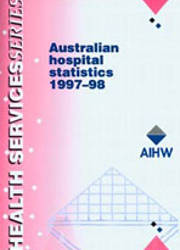Highlights
Hospitals, beds and staff
- There were 763 public acute hospitals operating in Australia in 1997–98.
- Although this figure suggests an increase in the number of hospitals since 1996–97, the variation is mostly due to changes in administrative arrangements which occur from year to year, and data are not comparable. A more useful indicator of the quantum of hospital services is the number of available beds. In 1997–98 there were 55,735 beds, a small decline from 56,836 beds reported in the previous year.
- One bed was available for every 332 Australians. This ranged from one bed for every 211 persons in remote areas to one bed for every 366 in metropolitan areas.
- Salaries and wages were 63% of total hospital operating costs in 1997–98.
- Nurses and salaried medical officers made up a little over half (53%) of total full time equivalent staff of public hospitals. The ratio was five nurses to one salaried doctor.
Patient numbers and lengths of stay
- The throughput of patients of both public and private hospitals in Australia continues to increase from year to year.
- Between 1996–97 to 1997–98, separations from public acute hospitals increased by 3% and from private hospitals increased by 6%. The private hospitals’ share of overall patient separations was 32% in 1997–98.
- Numbers of patient days in public acute hospitals were approximately equal to patient days in the previous year—15.2 million. Private hospital patient days increased by 3% to 6.0 million and were 27% of all patient days.
- The average length of stay in hospitals decreased in 1997–98, to 4.1 days from 4.2 days in 1996–97, following the overall pattern of decline shown in previous years. Private hospital stays averaged 3.3 days compared with 4.0 in public acute hospitals.
- A major factor in the shorter lengths of stay was an increased number of same day separations, now close to half of all separations (46.3%). For patients staying at least one night, average lengths of stay have fallen marginally over recent years.
- Fewer patients were admitted as private patients in public hospitals during 1997–98. Less than one in 10 public hospital patients were private patients, compared to one in six in 1993–94.
Patient characteristics
Age, sex and Indigenous status
- Females accounted for 54% of separations in 1997–98 although they comprised 50.3% of the population. There were more separations for females than males in all age groups from 15 to 54 years, which includes women who attend for childbirth, and in the 75 years and over age groups, where women outnumber men in the population.
- Australians aged over 65 years, comprising 12% of the total population, accounted for 31% of total hospital separations and 46% of patient days. The average length of stay for these patients was 6.0 days, compared with 4.1 days for all patients.
- Aboriginal and Torres Strait Islander peoples had almost twice the separation rate of the overall Australian population, 86% higher, after allowing for age structure. This higher rate is likely to be an underestimate because the identification of Aboriginal and Torres Strait Islanders as patients is incomplete.
Diagnoses, procedures and AN-DRGs
- Principal diagnoses in the National Health Priority Areas of cardiovascular health, cancer control, injury prevention and control, mental health and diabetes accounted for 41% of total patient days in 1997–98, representing more than 9 million patient days.
- Mental disorders (3.1 million patient days) and cardiovascular disease (2.5 million patient days) contributed most to this Priority Areas total.
- Patient days associated with diabetes as a principal diagnosis (166,495) were less than for other Priority Areas. However, when diabetes as an additional diagnosis was counted, the number of patient days increased to 2.2 million.
- For three out of four hospital separations, there was an operation or other procedure reported. Operations on the digestive system were the most commonly reported procedure in private hospitals. In public hospitals, operations on the cardiovascular system were the most commonly reported.
- The most common Australian National Diagnosis Related Group (AN-DRG) in public hospitals in 1997–98 was Admit for renal dialysis, accounting for 10.2% of total public hospital separations. Other common AN-DRGs included Chemotherapy (3.6%), and Vaginal delivery without complicating diagnosis (3.0%).
- The corresponding top three AN-DRGs in the private sector were Other gastroscopy for non-major digestive disease without complications and comorbidities, accounting for 6.0% of total private hospital separations, Other colonoscopy without complications and comorbidities (5.4%) and Lens procedures without vitrectomy and without complications and comorbidities (3.8%).



